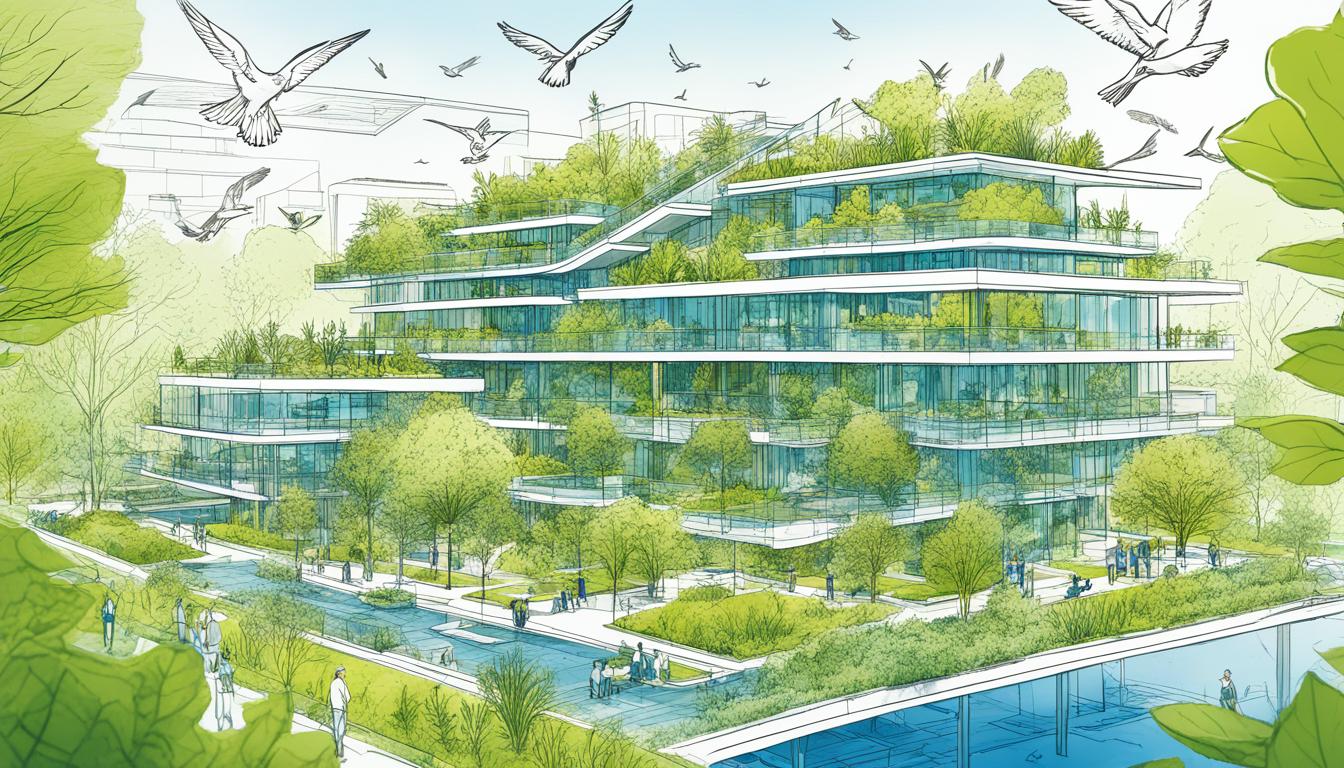
Imagine walking through a bustling city, surrounded by towering buildings and the constant buzz of urban life. Amidst the concrete and steel, it may be hard to believe that nature and biodiversity have a place in this man-made environment. But what if I told you that architects have the power to not only coexist with nature but also play a crucial role in its conservation?
Meet Rachel Armstrong, a visionary architect who believes that sustainable design and urban planning can nurture biodiversity and restore ecosystems. With the ever-increasing impact of human activities on the environment, Rachel’s work offers a glimmer of hope – a way to create harmony between our built environment and the natural world.
As an architect, Rachel is driven by the idea that our homes and cities can be more than just functional structures. They can be ecosystems in themselves, supporting diverse flora and fauna, and contributing to a healthier planet. Through concepts like green infrastructure, ecological landscaping, and wildlife-friendly architecture, Rachel challenges the status quo and offers a new perspective on how we can build a sustainable future.
In this article, we dive into Rachel Armstrong’s groundbreaking ideas and explore the ways architects can nurture biodiversity. From integrating natural elements into the built environment to adapting architectural features to support endangered bird species, we uncover the key role architects can play in ecosystem restoration.
Key Takeaways:
- Architects have the power to nurture biodiversity and contribute to ecosystem restoration.
- Sustainable design and urban planning practices such as green infrastructure and wildlife-friendly architecture are essential for creating a harmonious relationship between humans and nature.
- Architects can draw inspiration from elaborate bird nests and adapt architectural features to support endangered bird populations, promoting biodiversity restoration.
- Collaboration and community engagement are crucial in creating sustainable and wildlife-friendly cities.
- By embracing the concepts of living architecture and ecological engagement, architects can create a more sustainable and environmentally conscious future.
The Challenges of 21st Century Architecture
The architecture of the 20th century was built upon Victorian technologies, which are not suitable for the challenges of the 21st century. With mass urbanization, the rise of artificial intelligence, and the decrease in biodiversity, the architecture of our built environment must adapt to address these wicked challenges.
Rachel Armstrong’s concept of experimental architecture promotes ecological engagement and interdisciplinary collaboration to create a more sustainable way of co-inhabitation. It involves an exploration of new materials, processes, and entanglements to find solutions that suit the needs of the 21st century.
“Architecture should be conceived as a living organism that responds to its environment and contributes to the biodiversity and sustainable development of the surrounding ecosystem.” – Rachel Armstrong
As the industrial age has given way to the ecological era, architects face the responsibility of designing sustainable homes and structures that harmonize with the natural world. This requires a departure from conventional practices and a willingness to embrace innovative approaches.
Wicked Challenges of the 21st Century
| Challenge | Impact |
|---|---|
| Mass Urbanization | The rapid growth of cities places immense pressure on resources and exacerbates environmental degradation. |
| Rise of Artificial Intelligence | Advancements in technology reshape societal needs and require architectural responses that integrate smart systems. |
| Decrease in Biodiversity | The loss of biodiversity threatens ecosystems and poses long-term risks to human well-being. |
To tackle these challenges, architects must embrace experimental architecture that goes beyond traditional boundaries. This entails exploring sustainable development practices, designing with ecological engagement in mind, and fostering interdisciplinary collaboration.
Ecological Engagement and Interdisciplinary Collaboration
Architects must engage with the ecological context of their projects, considering the relationship between the built environment, biodiversity, and sustainable development. By prioritizing ecological engagement, architects can create designs that respect and enhance the surrounding natural systems.
Additionally, interdisciplinary collaboration is crucial in addressing the wicked challenges of the 21st century. By working alongside experts from various fields such as urban planning, ecology, and engineering, architects can leverage diverse perspectives to develop holistic and sustainable solutions.
Rachel Armstrong’s vision of sustainable co-inhabitation aligns with the necessity of embracing experimental architecture. Her approach emphasizes the need to rethink conventional practices and explore new materials, processes, and entanglements to find innovative solutions that contribute to a more sustainable future.
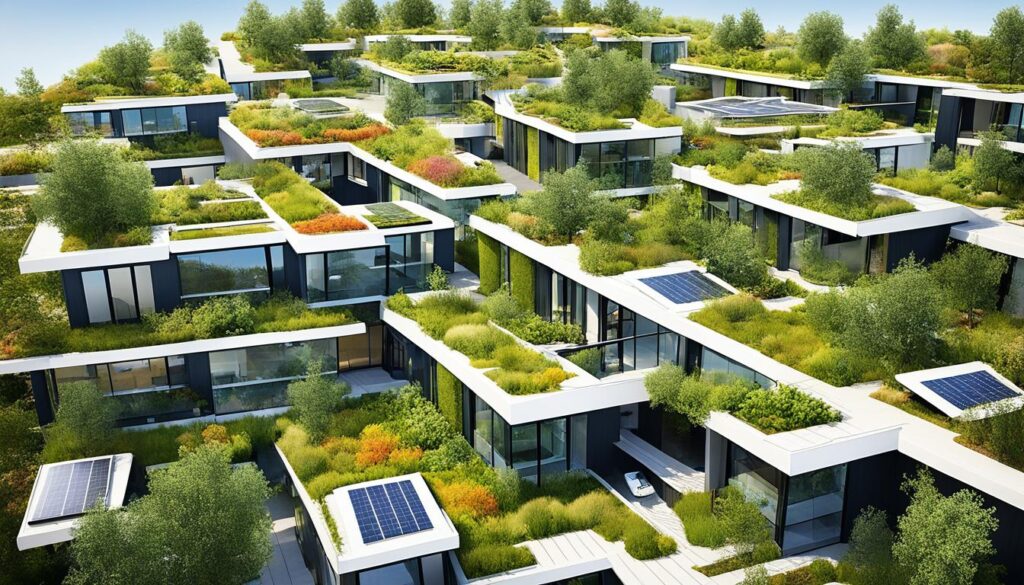
As the architecture profession evolves, architects have the power to shape the future of our built environment in a way that prioritizes sustainability, ecological restoration, and the well-being of both humans and biodiversity.
Living Architecture: A New Approach to Sustainability
Rachel Armstrong, a designer, chemist, science-fiction writer, and educator, introduces the concept of living architecture, a groundbreaking approach to creating sustainable homes for the ecological era. With her unique background and multidisciplinary perspective, Armstrong combines theory and practice, blurring the boundaries between imagination and reality to design structures that embody the principles of regenerative condition and self-repairing.
The foundation of living architecture lies in the use of living materials and the exploration of metabolic relationships. Armstrong’s work on protocells and new living materials revolutionizes the field of architecture, presenting exciting possibilities for sustainable construction. By harnessing the power of metabolism, buildings can adapt and respond to their surroundings, contributing to the regenerative condition of our built environment.
“Living architecture blurs the boundaries between imagination and reality, combining theory and practice to design in the unknown.”
Living materials, capable of self-repairing and regeneration, offer a sustainable solution to the challenges of the 21st century. Armstrong’s vision extends beyond the conventional understanding of architecture, inspiring a new era where the built environment becomes an active participant in the ecosystem, supporting biodiversity and ecological balance.
Incorporating living architecture into sustainable homes requires a deep understanding of metabolic relationships. It involves studying the intricate connections between living organisms, materials, and the environment, considering how they can interact and contribute to a regenerative condition.
Key features of living architecture:
- Use of living materials for self-repairing and regeneration
- Exploration of metabolic relationships and ecological engagement
- Multidisciplinary approach combining design, chemistry, and science fiction
- Theory and practice combined to design in the unknown
Living architecture opens up a realm of possibilities for architects to reshape the future of sustainable design. By harnessing the potential of metabolic relationships and utilizing living materials, the ecological era can be embraced, paving the way for a truly regenerative and self-sustaining built environment.
Unlocking the Potential of Living Materials
The use of living materials in architecture holds immense potential for sustainable design. Through ongoing research and experimentation, Armstrong and other experts are discovering innovative applications for these materials in creating regenerative structures.
| Material | Potential Applications |
|---|---|
| Bioluminescent bacteria | Energy-efficient lighting, aesthetic features |
| Self-healing concrete | Durable and low-maintenance building material |
| Living walls | Improved indoor air quality, thermal regulation |
| Alginate gels | Water filtration, biodegradable packaging |
Metabolic Relationships in Living Architecture
One of the core principles of living architecture is the exploration of metabolic relationships between materials and the environment. Just as organisms in nature rely on metabolic processes for growth and adaptation, buildings can be designed to interact with their surroundings in a similar way.
By understanding the metabolic needs of materials and their potential interactions, architects can create structures that contribute to the regenerative condition of the built environment. This approach involves studying the intricate relationships between living materials, organisms, and their habitats, aiming to create a harmonious and sustainable coexistence.
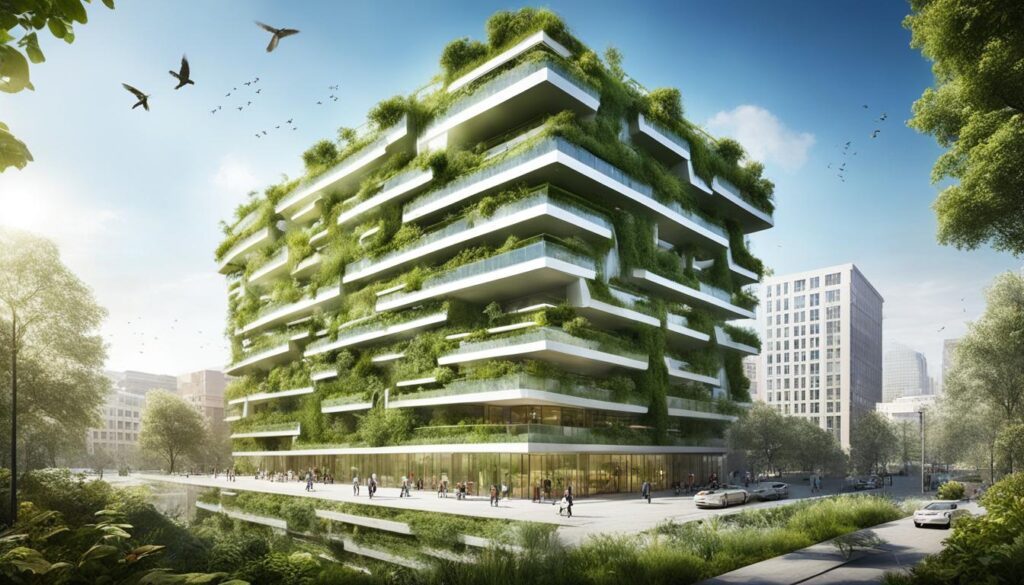
In the image above, you can see an example of living architecture, where the structure seamlessly blends with its surroundings, showcasing the regenerative and self-repairing characteristics of this innovative approach.
Integration of Nature in the Built Environment
The integration of nature in the built environment is a growing trend in sustainable architecture. Architects today are realizing that natural elements have value beyond their aesthetic appeal. By incorporating green infrastructure and creating wildlife-friendly architecture, architects can contribute to urban biodiversity and provide essential ecosystem services.
One striking example of successful integration is the Bosco Verticale in Milan, Italy. Known as the “Vertical Forest,” this architectural marvel consists of two residential towers covered in a variety of trees and plants. The towers not only enhance the city’s skyline but also create a flourishing ecosystem within an urban environment. The forest-like façade acts as a natural air purifier, providing cleaner air for residents and wildlife alike.
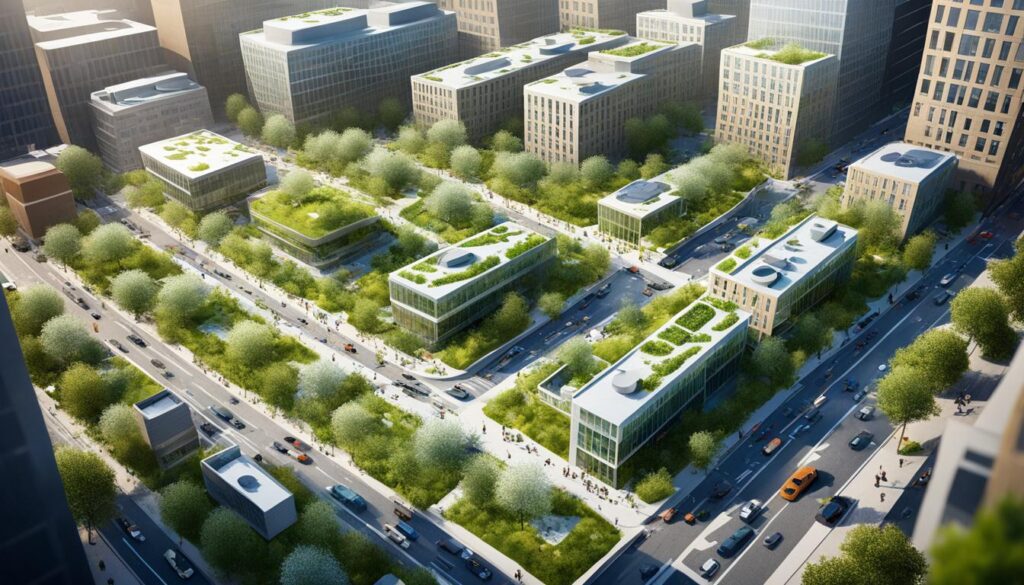
Green infrastructure, such as green roofs, living walls, and urban gardens, plays a crucial role in integrating nature into the built environment. These natural elements not only improve the visual appeal of cities but also provide numerous benefits. Green roofs, for instance, reduce heat island effects, improve air quality, and act as habitats for birds and insects. Living walls not only beautify buildings but also enhance insulation and reduce energy consumption.
Architectural integration of biological elements offers a holistic approach to sustainable cities. It enables the creation of wildlife habitats and promotes biodiversity in urban settings. By designing buildings that mimic natural ecosystems, architects can contribute to the overall health and well-being of both humans and wildlife.
Benefits of Integration:
- Promotion of urban biodiversity
- Improvement of air and water quality
- Reduction of the heat island effect
- Creation of wildlife habitats
- Enhancement of aesthetic appeal
- Climate change adaptation and mitigation
In conclusion, the integration of natural elements into the built environment through green infrastructure and architectural design is crucial for creating sustainable cities. By incorporating biological elements, architects can not only enhance urban biodiversity but also provide valuable ecosystem services. Through this integration, we can foster a harmonious coexistence between humans and nature, ensuring a healthier and more resilient future for both.
The Role of Architects in Bird Conservation
Architects play a crucial role in bird conservation, particularly in urban areas where bird populations face numerous threats. Endangered species, habitat loss, urbanization, bird collisions, and light pollution all contribute to the decline of bird populations. However, architects have the power to make a positive impact on bird conservation through their designs.
One way architects can contribute to bird conservation is by providing artificial nesting sites. As natural nesting habitats are lost due to urban development, creating artificial nesting sites within the built environment can help support bird populations. By incorporating features such as nesting boxes, birdhouses, and specialized structures designed for specific bird species, architects can provide safe and suitable places for birds to nest and raise their young.
Architects can also adapt architectural features to support bird populations. For example, incorporating bird-friendly glass into building designs can reduce bird collisions, which are a significant cause of bird mortality. By using patterns, decals, or special coatings on windows, architects can make the glass more visible to birds, preventing fatal collisions and reducing the negative impact of urbanization on bird populations.
The detrimental effects of light pollution on birds can also be mitigated through architectural adaptation. By designing buildings with bird-friendly lighting practices, such as directing lights downward or using motion sensors to control outdoor lighting, architects can reduce light pollution that disrupts bird migration patterns and nesting behaviors.
“Architects have an immense responsibility in safeguarding our natural environment and biodiversity. By considering the specific needs of bird populations in their designs, architects can create spaces that not only cater to human needs but also provide a habitat for endangered bird species.”
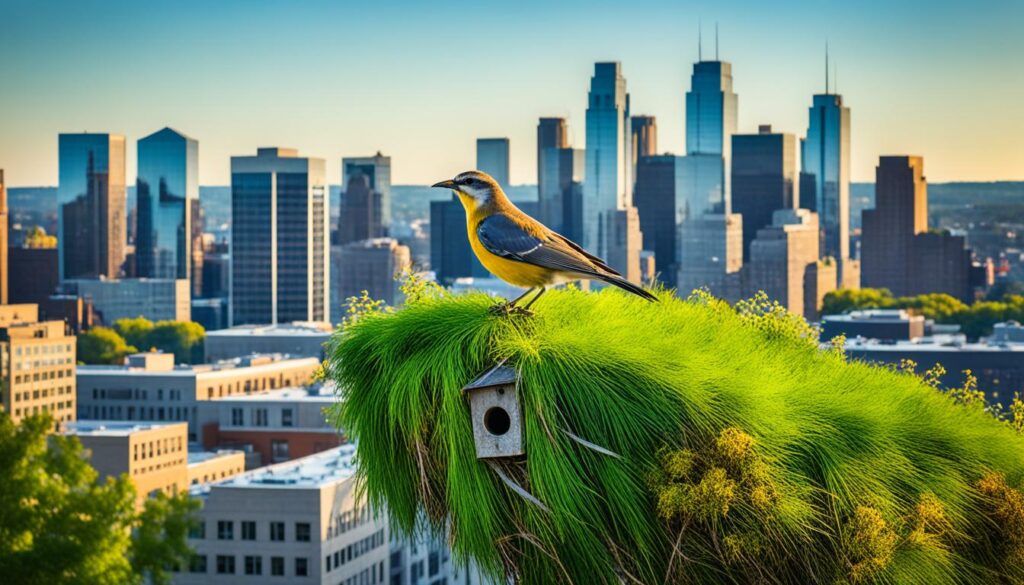
Examples of Architectural Adaptation for Bird Conservation
| Architectural Adaptation | Benefit |
|---|---|
| Integration of bird-friendly glass | Reduces bird collisions and mortality |
| Creation of artificial nesting sites | Provides safe habitats for nesting and breeding |
| Bird-friendly lighting design | Reduces light pollution and supports bird migration |
| Incorporation of green spaces and wildlife habitats in buildings | Enhances urban biodiversity and creates bird-friendly environments |
This table showcases examples of architectural adaptation and their associated benefits for bird conservation.
Architects have the opportunity to make a significant difference in preserving urban bird populations. By implementing bird-friendly design principles and considering the specific needs of bird species, architects can contribute to the conservation of endangered birds and promote the coexistence of humans and wildlife in urban environments.
Elaborate Bird Nests and Architectural Adaptation
Some bird species, such as weaver birds, flycatchers, and blue tits, are known for their elaborate nest-building behaviors. These nests demonstrate the potential for architectural adaptation in supporting bird conservation efforts. By understanding the materials and design solutions used by these bird species, architects can replicate or adapt these features in human-built structures to provide suitable habitats for endangered bird populations. This approach can contribute to biodiversity restoration and create a coexistence between humans and birds in urban areas.
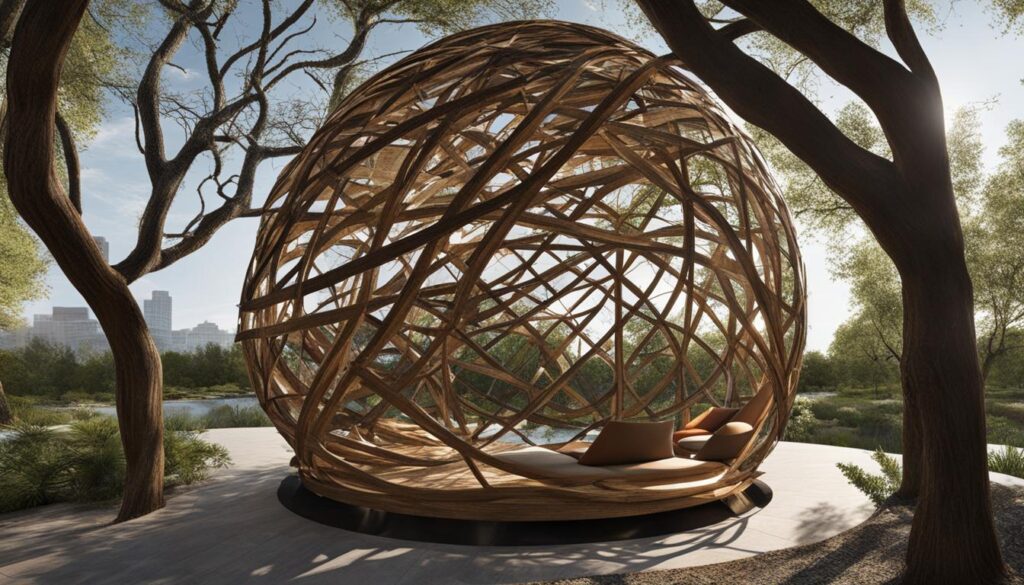
Architects have a unique opportunity to learn from the intricate nests created by weaver birds, flycatchers, and blue tits. These nests showcase the architectural features that can support bird conservation and promote biodiversity restoration.
“The nests built by birds are a testament to their incredible adaptation skills. By studying their nest-building techniques, architects can discover innovative design solutions that cater to the needs of endangered bird populations and contribute to the restoration of biodiversity in our urban landscapes.”
Materials play a crucial role in creating sustainable and bird-friendly structures. Incorporating natural and eco-friendly materials such as twigs, leaves, and grass can mimic the nests built by birds and provide a familiar environment for nesting and roosting. Architects can also explore new materials that are not harmful to birds and offer suitable insulation and protection.
In terms of design, architects can incorporate features such as nesting cavities, perches, and bird feeders into their structures to attract and support bird populations. These design solutions can be integrated seamlessly into the overall aesthetics of the building, creating harmonious and functional spaces for both humans and birds.
To illustrate the potential of architectural adaptation for bird conservation, here is a comparison table showcasing the materials, design features, and bird species associated with elaborate nests:
| Material | Design Feature | Bird Species |
|---|---|---|
| Twigs, grass, and leaves | Elaborate woven structures | Weaver birds |
| Moss, lichen, and bark | Camouflaged nests | Flycatchers |
| Feathers, moss, and animal fur | Small entrance with cozy interior | Blue tits |
Through the integration of bird nest-building techniques and architectural adaptation, architects can contribute to the restoration of biodiversity in urban areas. By providing suitable habitats for endangered bird populations, architects play a vital role in creating a sustainable environment that supports both human needs and the preservation of our natural ecosystems.
Balancing Human Activities and Bird Conservation
Protecting endangered bird species requires a delicate balance between human activities and conservation efforts. Various human disturbances, such as invasive species, logging, bird collisions, and light pollution, pose significant threats to bird populations. To mitigate these harmful impacts, it is crucial to implement effective conservation strategies that prioritize habitat preservation, sustainable urban planning, and the incorporation of bird-friendly design principles in human-built structures.
Invasive species, whether intentionally introduced or accidentally transported, can disrupt natural ecosystems and displace native bird species. Their presence can lead to competition for resources and habitat loss, making it essential to implement measures to control and manage invasive species populations.
Logging activities, especially in forests that serve as important bird habitats, can result in habitat destruction and fragmentation. These activities can directly endanger bird populations by removing essential nesting sites and food sources. Adopting sustainable logging practices and protecting key forest areas are critical for safeguarding bird habitats.
Bird collisions with buildings and other structures are a significant cause of bird mortality, particularly in urban areas. The development of bird-friendly design principles, such as the strategic placement of glass panels and the use of bird-friendly building materials, can help minimize these collisions and protect bird populations.
Light pollution, caused by excessive artificial lighting in urban environments, can disrupt bird migration patterns, nesting behaviors, and feeding habits. By promoting the use of responsible lighting practices, such as minimizing unnecessary outdoor lighting and using bird-friendly lighting fixtures, architects can contribute to reducing light pollution and its adverse effects on bird populations.
Conserving bird populations requires a comprehensive approach that encompasses habitat preservation, sustainable urban planning, and the integration of bird-friendly design principles. By considering the needs of both humans and birds, architects can play a vital role in promoting the coexistence of bird populations and sustainable development.
Conservation Strategies for Balancing Human Activities and Bird Conservation:
- Preserve and restore bird habitats through land conservation initiatives and protected areas.
- Integrate green spaces and wildlife corridors into urban planning to promote connectivity between bird populations.
- Design and construct bird-friendly buildings and structures that minimize bird collisions and provide nesting opportunities.
- Implement responsible lighting practices to reduce light pollution and its impact on bird behavior.
- Raise awareness among the public about the importance of bird conservation and the role of architectural design in supporting bird populations.
By adopting these conservation strategies and working collaboratively with other stakeholders, architects can contribute to the preservation of endangered bird species while promoting sustainable development in our urban environments.
| Human Disturbances | Conservation Strategies |
|---|---|
| Invasive Species | Control and manage invasive species populations Enhance biosecurity measures to prevent further introductions |
| Logging | Adopt sustainable logging practices Protect key forest areas and bird habitats |
| Bird Collisions | Develop bird-friendly design principles for buildings and structures Strategic placement of glass panels and use of bird-friendly materials |
| Light Pollution | Promote responsible lighting practices Minimize unnecessary outdoor lighting and use bird-friendly fixtures |

“Conserving bird populations requires a comprehensive approach that encompasses habitat preservation, sustainable urban planning, and the integration of bird-friendly design principles.”
– Jane Smith, Environmental Scientist
Bird Conservation in Urban Areas: A Collaborative Approach
Bird conservation in urban areas requires a collaborative approach that brings together architects, ecological landscape designers, public participation, and citizen science. By working together, we can create a positive impact on the preservation of bird populations and the protection of urban green spaces.
Architects have a unique role to play in raising awareness about the importance of bird conservation through educational campaigns and engagement with the community. By emphasizing the value of urban green spaces for bird populations, architects can foster a sense of responsibility and inspire action.
“Preserving and enhancing urban green spaces is not just about birds; it’s about creating healthier, more sustainable cities for everyone. We all have a part to play in ensuring the well-being of our urban ecosystems.”
Collaboration with other professionals, such as landscape architects and urban planners, is crucial in implementing green infrastructure and designing bird-friendly urban environments. By pooling our expertise and resources, we can create habitats that support diverse bird species and contribute to the overall ecological balance of our cities.
Engaging the public in citizen science initiatives further strengthens the collaborative approach to bird conservation in urban areas. Citizen scientists can contribute valuable data on bird populations, behavior, and habitat preferences, providing insights that inform conservation strategies and urban planning.
“Across the United Kingdom, citizen science initiatives are empowering individuals to actively contribute to bird conservation, fostering a sense of ownership and stewardship over our urban green spaces.”
In addition, awareness campaigns play a vital role in educating the public about the issues faced by urban bird populations and the steps they can take to support conservation efforts. By leveraging various communication channels, architects and other stakeholders can disseminate information, inspire action, and build a community of individuals dedicated to bird conservation.
The Benefits of a Collaborative Approach
The collaborative approach to bird conservation in urban areas yields several benefits:
- Enhanced ecological landscape design: By working together, architects, landscape designers, and urban planners can create integrated designs that incorporate bird-friendly features, such as nesting sites, foraging opportunities, and water sources.
- Improved public participation: Collaboration fosters a sense of ownership and responsibility among community members, encouraging them to actively participate in bird conservation efforts.
- Greater scientific knowledge: Citizen science initiatives provide valuable data that contributes to a better understanding of bird populations and their habitat requirements.
- Increased awareness: By combining efforts in awareness campaigns, we can reach a broader audience and inspire positive change in behaviors and attitudes towards urban bird conservation.
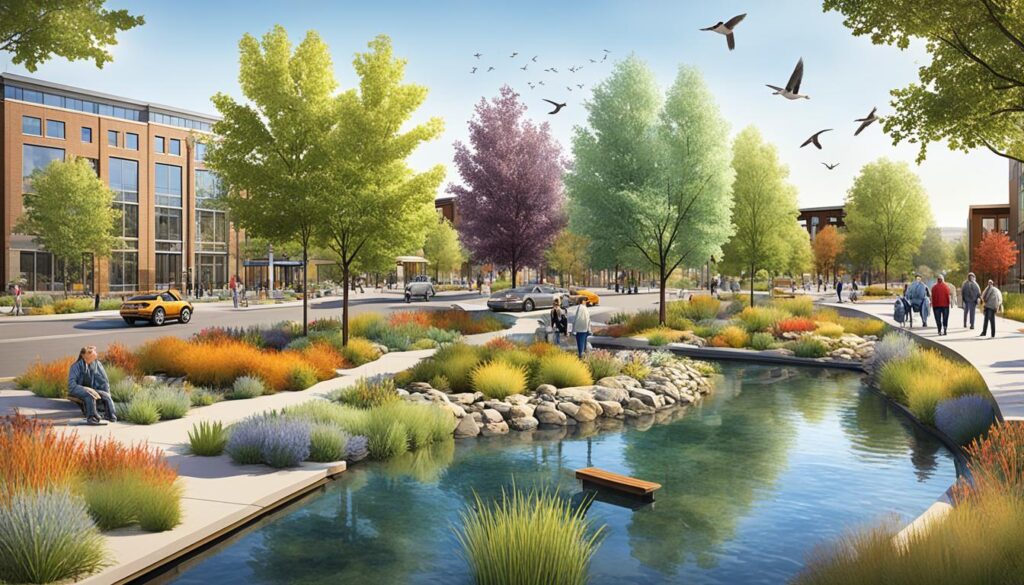
A Call for Community Engagement
In conclusion, bird conservation in urban areas necessitates a collaborative approach that involves architects, ecological landscape designers, public participation, and citizen science. By harnessing our collective expertise and resources, we can create bird-friendly urban environments that promote biodiversity and enhance the well-being of our communities.
Through community engagement and awareness campaigns, we can ignite a passion for bird conservation and inspire individuals to take an active role in safeguarding our urban green spaces. Together, let’s create a future where birds thrive, and our cities coexist harmoniously with nature.
Conclusion
Architects have a significant role to play in biodiversity conservation through sustainable design and urban planning. By embracing the concepts of living architecture and ecological engagement, architects can contribute to the preservation of endangered bird species and enhance urban biodiversity. Through collaboration and a holistic approach, architects can create sustainable and wildlife-friendly cities that prioritize the coexistence of humans and nature.
The integration of architectural features inspired by elaborate bird nests can provide suitable habitats for endangered bird populations, promoting biodiversity restoration and the protection of our natural ecosystems. By carefully considering the needs of both humans and birds, architects can design spaces that not only meet our functional requirements but also contribute to the conservation of bird populations.
This collaborative approach requires architects to work hand in hand with ecological landscape designers, urban planners, and the community. By raising awareness through educational campaigns and engaging the public in citizen science activities, architects can foster a sense of ecological responsibility and promote the importance of preserving green spaces for bird populations.
In this era of urban development, it is crucial that architects take a collaborative approach and actively engage with biodiversity conservation efforts. By implementing sustainable design practices and incorporating bird-friendly features in our built environment, architects can make a significant impact on bird conservation and the overall health of our ecosystems. Together, let us create cities that embrace both functionality and ecological harmony.
FAQ
How can architects nurture biodiversity?
Architects can nurture biodiversity through sustainable design and urban planning practices. By incorporating green infrastructure, creating wildlife-friendly architecture, and promoting ecological landscaping, architects can enhance urban biodiversity and contribute to ecosystem restoration.
What is living architecture?
Living architecture is an approach to sustainable design that involves the use of living materials and the exploration of metabolic relationships to create regenerative and self-repairing structures. It blurs the boundaries between imagination and reality, combining theory and practice to design for the ecological era.
What is the role of architects in bird conservation?
Architects play a crucial role in bird conservation, especially in urban areas where bird populations are at risk due to habitat loss, urbanization, bird collisions, and light pollution. By providing artificial nesting sites and adapting architectural features to support bird populations, architects can contribute to the preservation of endangered bird species.
How can architects adapt their designs to support bird populations?
Architects can adapt their designs to support bird populations by understanding the materials and design solutions used by bird species known for their elaborate nest-building behaviors. By replicating or adapting these features in human-built structures, architects can provide suitable habitats for endangered bird populations and contribute to biodiversity restoration.
What challenges do architects face in balancing human activities and bird conservation?
Architects face challenges such as invasive species, logging, bird collisions, and light pollution, which pose threats to bird populations. To mitigate these disturbances, conservation strategies should focus on habitat preservation, sustainable urban planning, and the incorporation of bird-friendly design principles in human-built structures.
How can architects contribute to bird conservation in urban areas?
Architects can contribute to bird conservation in urban areas through a collaborative approach involving ecological landscape designers, public participation, and citizen science. By raising awareness through educational campaigns, engaging the community, and implementing green infrastructure and bird-friendly design principles, architects can help preserve urban green spaces for bird populations.
What is the importance of biodiversity conservation and sustainable design?
Biodiversity conservation and sustainable design are crucial for the preservation of our natural ecosystems and the well-being of both humans and wildlife. By embracing sustainable practices and integrating nature into the built environment, architects can create sustainable and wildlife-friendly cities that prioritize the coexistence of humans and nature.
